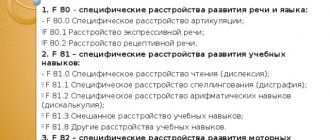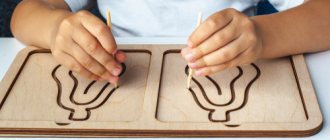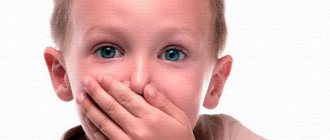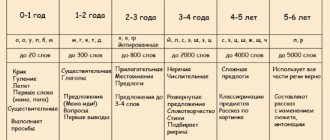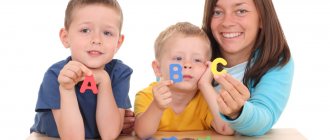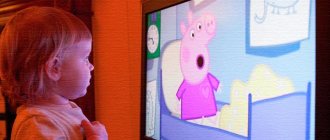Why does a psychotherapist and/or medical psychologist participate in a comprehensive diagnosis?
Many speech disorders have a complex, so-called combined origin. Thus, often defects or underdevelopment of speech are only an external symptom, while the causes of the disorder lie in the psyche and the functioning of the nervous system, as well as in the consequences of psychological trauma suffered by a person.
A striking example of such a speech disorder is stuttering, logoneurosis. This problem manifests itself as hesitation and intermittency of speech in a child or adult. But the causes of the disease can be both neurological and psychological, which means that the correction must be comprehensive.
The second common case of such a combined disorder is speech underdevelopment in children (ONR, SRR, motor alalia, sensorimotor alalia, speech underdevelopment in autism, cerebral palsy, mental retardation, mental retardation). More and more often, the real causes of speech underdevelopment in children (in addition to neurological problems) are hidden family problems, disharmonious upbringing, and disruption of parent-child relationships. That is why our Center employs a psychotherapist and a medical psychologist to diagnose complex speech defects.
Speech disorders
Causes of speech disorders
Speech disorders in adults resulting from brain damage: strokes, traumatic brain injuries, encephalopathies of various origins (toxic, traumatic, viral), as well as as a result of previous oncological diseases, can have different courses and manifestations. The mechanism of speech dysfunction can be of two types, depending on the location of the lesion - the cerebral cortex or subcortical regions.
Symptoms of speech disorders
With lesions of the subcortical parts of the brain, the innervation of the speech apparatus is disrupted, restrictions on the mobility of the speech organs (lips, tongue, soft palate) appear, discoordination of the processes of speech breathing and pronunciation occurs, and the muscle tone of the articulation organs is disrupted. As a result of these disorders, the patient's speech becomes slurred, unintelligible, a nasal tone often appears, and the voice becomes weak and poorly modulated. This type of speech disorder is called dysarthria. The main manifestation of speech impairment in dysarthria in adulthood is pronunciation difficulties.
With speech disorders resulting from damage to the cerebral cortex, speech function is disrupted as a system. Depending on the affected area of the cortex and the function it served, speech disorders will have their own specifics. Such patients may lose the ability to understand speech (with hearing intact), correctly pronounce words and individual sounds (while muscle innervation does not suffer), select the necessary words, construct phrases, and coordinate the parts of a sentence. Speech impairment due to lesions of the cerebral cortex is called aphasia. The speech of such patients can be represented by individual sounds, constantly repeated words or sound complexes, or a “word salad” of a chaotic set of sounds and words. With certain types of aphasia, patients experience difficulties with the very “launch” of the speaking process or the selection of individual articulatory movements necessary to pronounce certain sounds.
In some cases, there are combined speech disorders, in which aphasia is accompanied by dysarthria and vice versa.
Speech restoration
Rehabilitation and restorative training of patients with speech disorders is carried out by a neurorehabilitation specialist under the supervision of an attending neurologist. The neurologist conducts an examination, including functional diagnostics - EEG, ultrasound, evoked potentials. Next, the doctor describes the drug treatment regimen, prescribes physiotherapeutic measures, and calculates the speech therapy load adequate to the patient’s condition.
The neurorehabilitologist, in turn, determines the type and quality of speech impairment and develops an individual correctional route for speech restoration.
Comprehensive diagnostics is especially recommended for the following complex disorders:
Children:
- stuttering (logoneurosis), hesitation in speech, accelerated speech;
- speech development delay (SSD);
- general speech underdevelopment (GSD);
- motor alalia , sensorimotor alalia;
- early childhood autism (ECA);
- mental retardation (MDD);
- cerebral palsy (CP);
- organic lesions of the central nervous system;
- mutism (the child stopped talking after psychological trauma).
Adults:
- aphasia - impairment or loss of speech after a stroke or traumatic brain injury;
- stuttering (logoneurosis), hesitation in speech;
- speech defects as a manifestation of a general disease of the central nervous system (cerebral palsy, organic lesions of the central nervous system, consequences of disharmonious development, etc.).
International magazine
All children with intellectual disabilities have deficiencies in speech development. The specific features that define each type of developmental disorder are significantly fewer than those that serve as criteria for differential diagnosis [1].
First of all, this is due to the patterns of development of children with intellectual disabilities, and to the fact that special psychology at the present stage does not have enough comparative scientific research. The implementation of scientific developments in this area would significantly expand the possibilities for diagnosing speech development in children with mental retardation [2].
An analysis of the characteristics of the speech and mental development of children with intellectual disabilities shows that the correct assessment of mental development and the delimitation of mentally retarded children, especially with atypical forms (a combination of intellectual disabilities with various forms of alalia) from children with delayed speech development is a complex diagnostic task, especially in preschool age.
The greatest difficulty in making a speech diagnosis is observed in children with a history of cerebral palsy: the established diagnosis of “alalia” is often refuted and another type of speech disorder is diagnosed, in particular a spastic-rigid form of dysarthria, combining both pyramidal and extrapyramidal symptoms.
In this regard, the question of the role of the effectiveness of methods for diagnosing the speech development of children with intellectual disabilities is especially acute. A diagnostic study of a child with phenomena of speech disorders, as well as with other types of deviations in the psychophysical state, should begin with establishing an accurate diagnosis obtained from the results of differential psychological and pedagogical diagnostics.
For diagnosing speech development, psychological and pedagogical characteristics and individual psychological characteristics of the child, which are identified by educators, parents, speech therapists, psychologists and other teachers, are important.
Establishing a speech diagnosis follows general rules, but at the same time has its own specifics.
For example, difficulty in distinguishing between phonemic dyslalia and motor alalia arises in the later stages of alalia development. This occurs at a time when only phonemic disturbances are particularly pronounced in children’s speech, while disturbances in other subsystems of the language are either completely absent or weakened [3].
Decisive for differential diagnosis in such cases is anamnesis and comparative analysis of the study of the parameters of the child’s non-speech system.
The anamnesis clarifies the features of the early development of the child, starting from the prenatal period, the nature of childbirth and early postnatal development. Particular attention should be paid to the course of pregnancy in the mother, the presence of injuries received during childbirth, and asphyxia. The nature of the diseases that the child suffered in early childhood is also important. It is important to clarify with parents how any childhood illnesses progressed, whether they were accompanied by unconsciousness, seizures or convulsions. For example, the course of common childhood diseases (measles, whooping cough, pneumonia, influenza, etc.) can be complicated by damage to the nervous system (meningoencephalitis). The specifics of the speech anamnesis include clarification of the stages of early speech development (the nature of the child’s humming and babbling, his intonation, the state of hearing, the timing of the appearance of the first words, etc.) [4]. Thus, sometimes already at the stage of collecting an anamnesis, some information can be obtained that suggests a brain disease in early childhood.
The next stage in the diagnosis of speech disorders is neurological, speech therapy and psychological-pedagogical research.
Diagnosis of speech development is usually carried out by a speech therapist using various non-standardized methods and test tasks, which are not subject to assessment requirements for validity, reliability and representativeness.
An approximate list of stimulus material [5], which is used in a speech therapy study of a child’s speech development, is given below:
To study the phonetic side of speech, object pictures are used that contain sounds in different positions in a word (for example, the beginning, end, middle) and speech material (phrases, sentences and texts that contain different sounds).
To study the vocabulary and grammatical structure of speech, object pictures depicting actions and different numbers of objects are used.
The material for studying coherent speech is story pictures or a series of story pictures for different age groups.
The psychologist in the study, on the contrary, uses only methods that meet all the criteria for diagnostic material and have been adapted on a large sample of children with similar problems.
At different stages of pedagogical research, various methods are used to study the activities and characteristics of a child’s speech development: conversation, educational experiment, observation, study of documentation and written works of children.
The choice of methods for diagnosing speech development depends on the child’s communication skills, difficulty adapting to new conditions, anxiety, sensitivity and other individual characteristics, as well as on the goals and objectives of each stage of the examination.
The specificity of speech diagnostics lies in the fact that speech disorders often do not have the character of an independent disease, but are only one of the symptoms of the underlying disease.
For psychologists and speech therapists, it is difficult to diagnose children of preschool age who, according to their medical indicators, are at risk. The tempo delay in speech development is similar in its manifestations to the delay in mental development.
Diagnosis of speech disorders in children aged two to three years is also complicated by a number of difficulties that are caused by age and the lack of standardized methods.
The main methods for diagnosing speech development disorders in the examination of children are studying anamnesis and determining intellectual development [6].
For example, numerous studies that relate to motor alalia clearly indicate that children with motor alalia have mental retardation. The nature of this delay is interpreted differently by different scientists.
Children with oligophrenia, as well as children with motor alalia, have many similar speech manifestations of disorders. The fundamental difference between alalia and speech development disorders caused by intellectual impairment is that alalia is the result of failure to assimilate the structural and functional patterns of language in ontogenesis with complete or relative preservation of non-linguistic mental processes, whereas in oligophrenia it is the result of a violation of cognitive activity.
When assessing thinking, alaliki differ significantly from mentally retarded children. Children with motor alalia solve logical problems involving classification and similarity much better than oligophrenics.
In expressive speech, children with alalia try to convey cause-and-effect relationships using the linguistic means available to them. Children with intellectual disabilities do not express cause-and-effect relationships in speech, or express them at an elementary level.
Children with alalia have a rather extensive nominative vocabulary, which they cannot update in their speech. In children with intellectual disabilities, the supply of this knowledge is extremely limited.
Taking into account the above, for differential psychological and pedagogical diagnosis of speech development of children with intellectual disabilities, it is necessary, firstly, to identify the level of actual intellectual development of the child, and secondly, to determine the structures of the identified deviation [7].
In practice, the diagnosis of speech development is very problematic, especially in preschool age, and is often based solely on professional intuition.
What is the difference from traditional diagnostics?
Those who have already sought help know that the standard examination scheme includes a sequential appointment with specialists of different profiles, each of whom separately conducts diagnostics, makes a small conclusion and gives directions for subsequent procedures, and also develops their own treatment regimen. The flaw of such a system is that different specialists often make different (and often contradictory) diagnoses, based on their training and without the opportunity or desire to find out the opinion of their colleagues. As a result, an incorrect diagnosis leads to an incorrect correction scheme, which means the absence of any effect.
Article:
Currently, there is a rapid increase in the number of non-speaking children and children with certain speech disorders.
The prevalence of speech disorders, the variety of their causes, and the need to organize adequate assistance for children make this issue especially relevant. Modern scientific research proves that the first two to three years of life are decisive for a child’s development. Early childhood refers to critical periods of ontogenesis in the formation of all organs and systems. Today, up to 80% of newborns are physiologically immature, about 70% have diagnosed perinatal damage to the central nervous system (minimal cerebral dysfunction, perinatal encephalopathy, movement disorder syndromes, hyperexcitability, etc.), who subsequently experience a lag in psychophysical and speech development. The pathology suffered by the child in the perinatal period has a negative impact on the development of speech and at the age of 4-5 years he has various speech disorders: OSD, FFN, erased dysarthria - minimal dysarthria disorders and others. [1] Symptoms of these disorders were present from birth, however, the lack of a correct scientifically based approach to assessing a child’s mental development at the pre-speech level leads to late diagnosis of pathologies in young children and untimely provision of not only medical, but also psychological, pedagogical and speech therapy assistance.
According to educational psychologists, the period of early childhood has some psychophysiological features that distinguish it from subsequent age periods: the fastest pace of development; instability and incompleteness of emerging skills; greater physical and mental vulnerability of children, lability of their condition; interdependence and unity of physical and mental development; high plasticity and easy learning; high development potential; spasmodic and uneven development process; the dependence of children’s reactions on the nature of their emotional state; the need to receive sensory stimulation and active movement; the need to communicate with adults (parents, teachers), as well as with peers. [2]
There are age standards for speech development. They are described repeatedly and in detail in the relevant literature. It is the norms of speech development that are fundamental in diagnosis. But since each child has individual characteristics of speech development, it is advisable to consult a neurologist, audiologist, speech therapist who works with young children, or a child psychologist.
Children differ from each other in terms of development of both phonemic perception and the formation of motor skills of the speech apparatus. For timely and accurate diagnosis of speech disorders in children, it is necessary to take into account the patterns of normal speech development. The specificity of speech diagnostics lies in the fact that speech disorders most often do not have the nature of an independent disease, but are only one of the symptoms of the underlying disease.
Early detection and early comprehensive correction of deviations in speech development from the first years or even months of a child’s life make it possible to prevent the occurrence of further deviations in his development. In this regard, new diagnostic technologies for early detection and correction of deviations in the speech development of children are being created and put into practice. A combination of quantitative and qualitative approaches to data analysis is necessary, and qualitative differences between an abnormal and a normal child can only be established by comparing quantitative indicators.
The diagnosis of possible disorders of the pre-speech stage of development must begin at the stage of the maternity hospital and neonatal pathology departments, i.e. in the neonatal period. Delay in speech development is detected from the first weeks and months of life. Newborns at this age may experience a number of different types of pathological changes: in the motor sphere (impaired visual-motor coordination, general muscle tone and manipulative activity); in the structure and functioning of the articulatory apparatus (irregular shape of the hard palate, underdevelopment of the lower jaw, massive tongue, shortened hyoid ligament, impaired muscle tone of the facial muscles and muscles of the tongue, lips); voices (voice monotonous, exhausted, lacking intonation expressiveness); breathing (shallow, arrhythmic); in the emotional sphere (difficulty in establishing emotional contact, late appearance of positive emotions, lack of interest in the environment and the need to communicate with adults). [3]
The main part of diagnostic activity is determining the speech status of the examined child, determining the presence of speech pathology, its structure and severity. The initial theoretical basis for developing the principles of diagnosis and organization of correctional work was the doctrine of patterns, compensatory and reserve capabilities, as well as the driving forces of child development.
During the examination, it is necessary to pay special attention to the patterns of child development in the early stages of ontogenesis, using anamnesis data. During an individual examination, it is important to find out the characteristics of behavior and those main deviations or speech disorders that will allow you to substantiate a speech therapy conclusion. [4, p. 3]
Currently, there are many options for speech therapy examination of young children (starting from birth) with various speech development disorders, including speechless children. Each specialist usually develops his own methodology based on the classical ones. Depending on the purpose and focus of the examination, as well as the qualifications of the teacher, a different number of indicators of the child’s speech and general development are included in the diagnosis. It makes no sense to wait until the child speaks on his own, stops being lazy, speaks as a result of visiting kindergarten, etc., because you can miss a favorable period for speech development. Parents with “silent” children who are already four, five or more years old often seek advice. In such cases, correctional work is long, difficult and, unfortunately, does not always lead to the desired result. An early age provides great opportunities for correcting speech disorders due to the plasticity of the child’s psyche and sensitivity to various kinds of psychological and pedagogical influences.
It is important to identify not only the delay in the formation of speech functions, but also differentiation - whether this delay is benign (tempo) or pathological, requiring urgent speech therapy and medication correction. There are various classification options for this pathology, which have become widespread, but none of them meets the requirements of expert practice for several reasons: either such an important parameter as the severity of the disorders is not taken into account, or the principle of nosological homogeneity of the classified groups is not observed. [5]
In the process of examining children with speech pathology, it is necessary to be able to differentiate alalia and other speech development disorders (speech underdevelopment in mental retardation; speech disorders in early childhood autism, deafness or hearing loss; aphasia; dysarthria; temporary delays in speech development of a functional nature) in order to correctly assess the significance (persistence and severity) of disorders of language and speech functions and determine the set of necessary rehabilitation measures.
Thanks to the successes of neuropsychology, it has been established that speech has a dynamic cerebral localization; scientists have identified specific zones that carry out its different aspects. The integrative work of all speech zones ensures the implementation of the speech function as a whole, but different parts of the brain have priority in providing its individual types. [6] If the activating influence of the frontal lobes is insufficient, delays in psycho-speech development are formed: with minor disturbances - tempo (which are subsequently, as a rule, overcome), with severe ones - up to an intellectual defect. Rate delay in speech development (RDS) in its manifestations can be similar to delayed mental development. In children with only tempo developmental developmental development, as a rule, in contrast to children with delayed mental development, all non-speech functions are developed in accordance with age norms and the deficiency is directly manifested only in expressive speech. Comprehension in cases of delayed speech development is usually preserved.
The main point is to understand that similar speech states in different children of the same age are caused by different reasons. As a result, one of the children will speak on his own because he had a delay in speech development; another will benefit from classes with a special psychologist and speech therapist; the third will never speak because he will not be shown to a specialist in time and will not receive the necessary treatment; the fourth stopped speaking as a result of acute stress disorder. One child does not speak because he has severe organic brain damage and needs specially organized comprehensive classes to stimulate speech development, another did not have the need to speak due to the child’s pedagogical neglect, then work with parents is necessary first of all.
Thus, the causes of speech disorders may be a general lag in the mental development of the child, pathology of pregnancy and childbirth, the consequences of perinatal encephalopathy, dysfunction of sensory integration, the presence of damage to the articulatory apparatus, damage to the hearing organ, the influence of heredity and unfavorable social factors (insufficient communication, improper upbringing conditions ), various somatic and psychoneurological diseases of the child, various kinds of psychological trauma, overstimulation of visual information due to the abundance of television shows, cartoons and educational programs for children [7] Difficulties in learning speech occur in children with retarded physical development who have suffered severe diseases caused by malnutrition. Also, delayed speech development may be associated with the presence of autism in a child.
Speech therapy work on the prevention of speech disorders in young children at risk should be built taking into account the main provisions of special pedagogy in the field of early intervention: early targeted and differentiated “step-by-step” training; use of specific methods, techniques, teaching aids; individualization of training; mandatory inclusion of parents in the developmental process. The speech development of young children is very flexible, therefore it is necessary to correctly develop and select a program of correctional and developmental education to increase the level of general speech development of children and prevent possible speech development disorders in the future.
Literature
Chirkina G.V. Current problems in the development of speech therapy science // Defectology. - 2012. - No. 1. - P. 3–9.
A guide for practical psychologists and other specialists working with young children / M. G. Borisenko, O. E. Kamyshnikova, T. F. Kiryanova, N. N. Rachkovskaya. – St. Petersburg: Paritet, 2008. – 64 p.
Differential diagnosis of speech disorders in children of preschool and school age: Method. recommendations / compiled by L. V. Venediktova and others. St. Petersburg: Childhood - Press, 2010
Volkova G.A. Methods for examining speech disorders in children. – SPb.: RGPU im. A.I. Herzen, 1993. – 45 p.
Vladimirova I.A., Kolyado V.B., Lobanov Yu.F., Goncharenko A.G., Samarin B.A., Akimov E.I. and others. Medical and social examination of speech pathology in children. Toolkit. Barnaul – 2007
Wiesel T.G. Fundamentals of neuropsychology. M. - 2005.
Efimov O.I., Efimova V.L. 15 myths about children's speech. Dialogues between a neurologist and a speech therapist about children's speech. — “Publishing house “Dilya”, 2013. — 224 p.
Differences in complex diagnostics in our Center:
- Collegiality - specialists of various profiles jointly conduct comprehensive diagnostics, which means the final diagnosis is more reliable.
- Diagnostic observation. While one of the specialists is directly conducting the examination, other specialists have the opportunity to observe from the side in order to assess the quality of contact, the client’s psycho-emotional reactions and other small details that will help determine the real causes of the problem.
- Collecting as much information as possible. During complex diagnostics, specialists distribute the collection of profile information among themselves. For example, while a speech pathologist-defectologist examines a child, a psychotherapist talks with parents and collects anamnesis, etc. This approach allows each specialist to form their own opinion about the situation, in order to then discuss it with colleagues and come to a common conclusion. conclusion.
- Save time and formal conclusion. As a result of a 60-minute comprehensive diagnosis, you receive an expert opinion from 2-3 specialists, as well as a written conclusion on the form and stamp of our Center.
- Saving money. The cost of comprehensive diagnostics is lower than individual consultations with relevant specialists.
Encyclopedia of methods of psychological and pedagogical diagnosis of persons with speech disorders
In the first three years, intensive physical, emotional and mental development of the child occurs. The baby gets acquainted with the various properties of objects and initially masters those of their sensory features that are useful for performing actions - shape and size. His perception during this period is based on external indicative actions, i.e., mastering the surrounding world is carried out through trial and error.
In the third year of life, the child begins to understand that there are many objects that have the same properties. These properties acquire independence, and their repertoire (shapes, colors, ratios of magnitudes, spatial relationships, etc.) is constantly expanding, which is very important for his further mental development.
Of great importance for the mental development of a child is the development of attention, which is associated with the direction and selectivity of cognitive processes. Attention allows you to achieve accuracy and detail of perception, strength and selectivity of memory, direction and productivity of mental activity. Up to 3 years of age, the child’s attention is involuntary, but with the development of speech it is increasingly replaced by voluntary attention. All aspects of attention receive development: concentration, stability, volume, distribution and switching.
The age from one to two years can be called the period of fixed attention. In connection with mastering speech, the baby learns to maintain attention not only on objects, but also on words and phrases. Mastering the functions of objects and improving actions with them requires addressing an increasing number of their properties, and therefore contributes to improving the switching of attention. Interaction with two objects develops the ability to distribute attention. If in the second year of life the baby masters the concentration of attention of his choice, then after 2 years he develops flexibility of attention due to quickly switching from one activity to another. However, the direction of a child's attention is still largely determined by adults. Three-year-old children can already maintain attention on the game for up to 30–40 minutes. Games and exercises, including mental and physical activity, during this period contribute to training the distribution and concentration of attention.
Development would be impossible if the acquired experience were not stored in the child’s memory. Memory consists of the processes of imprinting, storing and reproducing information. Depending on the type of information reproduction, memory is divided into visual, motor (motor) and verbal, and depending on the duration of information storage - short-term and long-term memory. Research shows that memory for visual impressions, actions, and even events develops very early and is relatively strong. Up to 3 years of age, involuntary memory predominates and does not require the child’s active conscious participation. At the beginning of the second year, memory is separated from the process of perception, the ability to reproduce an object in its absence arises, the interval between memorization and recognition lengthens, and the child can memorize several objects. Verbal-semantic memory begins to develop intensively. At the age of 2 to 3 years, intensive development of verbal memory occurs.
Another important mental process is thinking, which is divided into objective-active, visual-figurative and verbal-logical. Thinking begins to form only on the basis of actions with objects after the appearance of the act of grasping. After the first year, a transition occurs from using ready-made connections shown to adults to establishing them independently. The child masters reality by trial and error and gradually acquires the skills of abstraction and generalization. After 2 years, the child begins to perform mental actions in his mind, without resorting to external tests. At the same time, he relies on images of objects, ideas about the ways of their use. This is how the child’s visual-figurative thinking is formed, in which problem solving occurs as a result of imaginary actions with objects. But for some time both types of thinking coexist, and when solving complex problems the child returns to using objective-active thinking. Gradually, the baby accumulates more and more ideas about the general properties of objects - their shape, color and size. With the development of speech, the sign (symbolic) function of consciousness begins to form, in the formation of which adults play the leading role, since the sign function is not discovered, but is acquired by the child. Both samples of substitutions and samples of game renaming of objects are given by an adult. At an early age, different types of thinking do not always develop in harmony.
With general intensive development in the first three years of a child’s life, passive speech is ahead of active speech. There is a certain proportionality in the replenishment of passive and active vocabulary. First, the child learns to understand instructional words, then name words, later instructions and assignments, and finally stories, i.e., contextual speech. A healthy child is able to master any language in the first three years, and in a bilingual environment, two. With age, most children lose their “linguistic genius”, as the formation of the structures responsible for language development ends. Children are well prepared for speech perception, as they have innate or very early developing abilities to recognize speech sounds (phonemes). During the critical period, children very quickly grasp the phonemes of the language they constantly hear, and it becomes their native language. On the other hand, at birth, the ability to hear differences between phonemes is not yet limited to the language they hear at home. The universal ability to distinguish between phonemes of different languages is lost by children around eight months. The ability to understand speech addressed to them improves up to approximately 1.5 years. During this period, children quickly learn the names of objects and actions. The second year is decisive for the emergence of independent speech. Vocabulary exceeds 50 words. When pronouncing their first words, children use different verbal strategies. With the expressive strategy, most of the first 50 words are names of actions and names of people, with the referential strategy - names of objects. Those children who prefer to use the names of objects increase their vocabulary faster. At this age, the child begins to use two-word sentences in which certain grammatical patterns are revealed. At the age of 2 to 3 years, the child begins to enter into dialogues not only with adults, but also with children. The vocabulary increases rapidly and by the age of 3 it can reach 1000 words. R. Brown identifies two successive stages of language acquisition for this age. After going through the period of forming two-word sentences, children increase the number of words in a sentence to three or more, and can form various verb forms, as well as plural nouns and possessive adjectives. At the next stage of language acquisition, children begin to use negative, imperative and interrogative sentences in their speech. The planning function of speech begins to form. A descriptive speech-monologue appears.
In examining children of early preschool age, non-standardized methods are usually used. Usually these are play techniques with objects familiar to the child: cubes, pyramids, pictures, etc. It is carried out in a free form, and considerable attention is paid to the observation method. The specialist conducting the examination must be well versed in age norms and take into account the individual conditions of the child’s development (for example, whether he attended any child care institution or was at home).
For children of this age who belong to the “risk” group, whose history shows signs of predisposition to the appearance of speech disorders, methods that allow us to identify the degree of development of non-speech functions are significant. It is the lag in psychomotor development, the lack of ability to follow instructions, the lack of formation of sensory standards in accordance with age that are signs of impaired development. In the absence of speech, it is especially important to pay attention to the characteristics of the child’s auditory and visual perception, to evaluate his memory, voluntary attention and psychomotor activity.
The basis of examining a child of early preschool age is collecting information. A detailed anamnesis can be an important prognostic part of the entire examination and selection of diagnostic techniques. As a rule, the collection of psychological history is carried out from the parents’ words in the form of a structured interview.
The questionnaire below allows you to characterize the prenatal, natal and postnatal periods of child development. Based on the information obtained with its help, the psychologist can assume the presence of certain problems in the child and correctly organize the methodology for his examination.
Questionnaire for parents of children of early preschool age
Hour, day, month, year of birth of the child.
1. What kind of pregnancy is the child from, how did the previous ones end (abortion, miscarriage, childbirth)? How long has passed from the last pregnancy to the present one, were there any worries, tensions, or illnesses before the pregnancy?
2. Was the pregnancy planned (expected), desired in principle, but premature in time, or undesirable due to various circumstances (study, work, life and family circumstances)?
3. Was the sex of the child consistent with what was expected by the mother and father?
4. Mother's age at birth, father's age.
5. How did the pregnancy proceed: a) in the first half; b) in the second half? Nature of pregnancy pathology: falls, bruises, injuries, psychoses, diseases. Expressed anxiety during pregnancy due to family situation, housing conditions, living with parents, relatives, studies, exams and illnesses of loved ones.
6. Neuropsychic illness of mother, father.
7. Diseases of relatives: epilepsy, mental illness, tuberculosis, alcoholism, stuttering, drug addiction, syphilis.
8. Childbirth: early, urgent, fast, rapid, dehydrated. Stimulation: mechanical, chemical, electrical stimulation. Shout: yes, no. Asphyxia: white, blue.
9. Rh factor: negative, compatibility.
10. Weight and height of the child at birth.
Feeding: applied to the breast for a day (took the breast actively, did not take it, took it with help, sucked actively, fell asleep during feeding, got tired quickly, regurgitation, choking). Breastfeeding before, subsequent feeding: mixed, artificial before.
11.Discharge from the maternity hospital____for the day.
Additional time spent in the maternity hospital, reasons____________.
The child’s condition in infancy: calm, restless, lethargic, loud, whiny, etc. How long did he suck on a pacifier or pacifier____________________.
He preferred tight swaddling (he calmed down at the same time), free time without clothes, when possible.
12. Diseases in the 1st month of life: sepsis, influenza, anemia, pneumonia, dyspepsia, jaundice, etc._____________________.
Diseases in the 1st year of life: pneumonia, influenza, scarlet fever, whooping cough, dysentery, etc.__________________.
Diseases from 1 year to 3 years: ______________________.
13. Head injuries: with loss of consciousness, without loss of consciousness. Closure of the fontanel: early, normal.
14. In the first years of his life, he did not pay attention to himself or was drowsy, lethargic, lethargic, slept constantly or vice versa, was restless, loud, confused day and night, refused to take the breast, and was extremely difficult to calm down. Note the possible causes of the cry: birth trauma, not enough milk, fatty milk, mother's worries during breastfeeding, family environment: noise, conflicts. Did you flinch at loud noises in the first months of life or start crying at the same time?
Features of motor skills formation
1. Hold your head with _____________.
2. Development of hand movements: took a bottle of milk, objects with _________________.
3. Movements from back to side with, from back to stomach with _______________________.
4. Started sitting without support since __________________.
5. The first attempts to pull yourself up, grab onto the fingers of an adult with _________.
6. I walked smoothly and jogged, often falling with _______________.
7. Showed extreme fearlessness.
8. Nature of motor impairment: excessively mobile, fussy, inhibited, clumsy.
9. Motor skills: gets dressed with__________, undresses with_____________, buttons up with_____________, eats independently with____________, regulates physiological needs with_________.
10. Right-handed, left-handed, ambivert (have there been any attempts to retrain left-handedness).
Relationship development
1. Specific reactions to other children: smiles, reaches out to others, tries to take toys from him.
2. He began to show an emotional attitude towards one child with _________, towards a group of children with _________.
3. Rarely comes into contact with adults, children, and teachers. Stays aloof and does not seek contact.
4. Gets tired quickly from large groups of children and prolonged contact with them.
5. Initiative in communication, negative, unstable communication, stubborn, conflictual.
Play activity
1. Emotional attitude to the game:
a) active: is an organizer, cheerful, cheerful;
b) unstable: increased excitability, aggressive, mood changes often, psychomotor restlessness, tendency to whims and affects, inappropriate expression of joy and grief, unable to play the same game for a long time, quarrels and fights with the guys.
2. Is there fiction and fantasy___________.
3. What role does ______________ play in the game.
4. How conflicts are resolved__________________.
How is a comprehensive diagnosis carried out?
Comprehensive diagnostics are carried out by appointment. At the appointment, depending on the individual case (a child or an adult is being examined; how many people are present at the consultation; what is the expected diagnosis, etc.), specialists collect anamnesis, examine the emotional, cognitive, behavioral spheres of the psyche, characteristics of upbringing, family relationships; separately diagnose speech and its disorders; assess the degree of exposure to stress and traumatic factors. For diagnosis, special techniques, questionnaires, diagnostic conversations, observation, etc. can be used.
At the end of the consultation, specialists give an oral conclusion, recommendations, and answer questions. Recommendations include an individual scheme for further correctional work. After the appointment, a conclusion is drawn up consisting of 3 parts: speech therapy, psychological and recommendations.
Early diagnosis and correction of speech development
Current problems of early diagnosis and correction of deviations in the development of speech in children from birth to 3 years.
The problem of early assistance to children is currently extremely relevant, since the proportion of births of healthy newborns has decreased to 35% in recent years. Today, up to 80% of newborns are physiologically immature, about 70% have diagnosed perinatal damage to the central nervous system (minimal cerebral dysfunction, perinatal encephalopathy, movement disorder syndromes, hyperexcitability, etc.). Subsequently, children with indicators of dysontogenesis experience delays in psychophysical and speech development. Pathology suffered by a child during the perinatal period has a negative impact on speech development. The diagnosis of PEP is removed by the end of the first year of life, because no pronounced violations are detected. As a result, normal development is observed in 15-20% of children. But our long-term observations show that these children at the age of 4-5 years have various speech disorders: OSD, FFN, erased dysarthria and others. Symptoms of these disorders were present from birth, because the causes of disorders relate to the prenatal or infancy period.
Delay in speech development is detected from the first weeks and months of life. In newborns at this age, a number of pathological changes may be observed: - motor sphere (impaired visual-motor coordination, general muscle tone and manipulative activity), - structure and functioning of the articulatory apparatus (irregular shape of the hard palate, underdevelopment of the lower jaw, massive tongue, shortened hypoglossal ligament, violation of the muscle tone of the facial muscles and muscles of the tongue, lips), - state of the voice (monotonous, exhausted, devoid of intonation expressiveness), - state of breathing (shallow, arrhythmic), - emotional sphere (difficulty in establishing emotional contact, late appearance of positive emotions, lack of interest in the environment and the need to communicate with adults).
Modern scientific research proves that the first two to three years of life are decisive for a child’s development. Early detection and early comprehensive correction of developmental deviations from the first years or even months of a child’s life make it possible to prevent the appearance of further deviations in his development, correct existing violations, significantly reduce the degree of social insufficiency of children, achieve a higher level of development, as well as more successful integration into society. In this regard, new pedagogical technologies for early detection and correction of deviations in the sensorimotor and speech development of children are being created and put into practice. Parents are consulted on issues of early development, a comprehensive diagnostic system has been developed to identify deviations and early start of systematic correctional work.
In our center, targeted training of specialists is carried out for comprehensive correctional work with young children, the “Healthy Baby” program has been created
The “Healthy Baby” program was created for children from birth to three years old, with lag and risk of lag, where family education is given a large role. Methodological recommendations have been developed for psychological and pedagogical support of children in infancy and early childhood, which are addressed to parents in order to enhance their participation in the process of raising a child.
The peculiarity of psychological and speech therapy work is that the program is aimed at identifying deviations in the early development of the child, the accuracy of diagnosis, timely, high-quality correction, taking into account the compensatory capabilities of the baby, allowing parents to hope for a favorable prognosis and minimize relapses.
The system of classes includes the following main directions of correctional work: • Development of emotional reactions; • Development of visual and auditory perception; • Development of hand movements and actions with objects; • Formation of the preparatory stages of development of speech understanding; • Normalization of the condition and functioning of the articulation organs through differentiated and acupressure massage, articulatory gymnastics; • Development of the preparatory stages of the formation of active speech.
These directions vary depending on the child’s age, level of development and capabilities. In this case, a gradual complication of techniques aimed at developing speech and the formation of all mental functions of the child is assumed. Interesting motivational techniques, the use of emotional, musical, clear speech patterns and a logically determined change in children's activities constitute a novel approach to conducting classes with children with systemic disorders.
The “Healthy Baby” program contains several blocks that meet the age needs of a child from 8 months. up to 3l. The program includes 10 sessions with a psychologist and 10 sessions with a speech pathologist.
You can sign up for the lesson program by calling 939-26-56 from 10 a.m. to 9 p.m.

